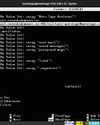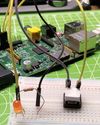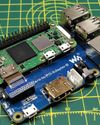Emulate classic Apple computers
Linux Format
|February 2021
Les Pounder goes back to his distant college days and reveals how to emulate the Apple desktop machines that he used for work and play.

Apple Computers was founded on 1 April, 1976, by college dropouts Steve Jobs and Steve Wozniak. From these humble beginnings we now have a brand that is just as much about style and design as it is computing prowess.
Apple Computers’ first computer was the Apple I. In 1977 the Apple II was released and it soon found its niche in US schools. After this we saw the Apple Lisa (1983), a merging of the Apple II aesthetic with what would become the Macintosh range of machines. Sadly Lisa was a flop, but in 1984 we saw the introduction of the Macintosh range with the Macintosh 128. This small machine changed the fortune of Apple and it started a range of Macintosh machines that exists to this day, in the form of the iMac. In this tutorial we’ll take a look at the classic era of Apple Machines.

An Apple a day
There are many ways to emulate an Apple machine, and one of the most popular is to use Basilisk II which is an emulator for Apple machines using the Motorola 68000 series CPUs. This was the pre-OS X era, an era where this author was at college and using System 7.5 OS and Netscape Navigator to go online.
To install Basilisk II on our Ubuntu machine we downloaded the latest release from https://launchpad.net/ubuntu/bionic/+package/basilisk2, then opened a terminal in our Downloads folder and installed the package using the following:
$ sudo dpkg -i basilisk2_0.9.20120331-4_amd64.deb
Once installed, open the Basilisk II application:
$ BasiliskII
We immediately see the
このストーリーは、Linux Format の February 2021 版からのものです。
Magzter GOLD を購読すると、厳選された何千ものプレミアム記事や、10,000 以上の雑誌や新聞にアクセスできます。
すでに購読者ですか? サインイン
Linux Format からのその他のストーリー

Linux Format
Create your first WebSocket service
Mihalis Tsoukalos explains how to use the Go programming language to work with the WebSocket protocol.
9 mins
April 2023

Linux Format
Fantastic Mr Firefox
Nick Peers takes a trip down memory lane to reveal the story behind the rise - and slight fall - of Mozilla's popular web browser.
9 mins
April 2023

Linux Format
Set up your terminal and email like it's 1983
Jump in the hot terminal time machine with Mats Tage Axelsson who emails from the command line using the latest technology.
8 mins
April 2023

Linux Format
Universal layer text effects with GIMP
Posters use them, films and presentations are hard to imagine without them: text effects. Attract attention with Karsten Günther and GIMP.
8 mins
April 2023

Linux Format
Jump to a federated social network
Nick Peers reveals how you can get up and running with this free, decentralised and non-profit alternative to Twitter.
9 mins
April 2023

Linux Format
Free our SOFTWARE!
Taking anything for granted is dangerous, so Jonni Bidwell and Mike Saunders revisit how the free software movement got started to help free us from proprietary tyranny!
4 mins
April 2023

Linux Format
Master RPI.GPIO
Les Pounder goes back to the early days of the Raspberry Pi - and his career with this classic library! -
5 mins
April 2023

Linux Format
Waveshare Zero to Pi3
Transform your Pi Zero into a Pi 3, they promised Les Pounder, but it's more like adding on go-faster stripes.
2 mins
April 2023

Linux Format
The Best OPEN SOURCE Software Ever!
In an attempt to trigger controversy, Michael Reed and Neil Mohr unequivocally state these are the greatest free software apps ever. Probably. We’re just trying to be helpful.
19 mins
April 2023

Linux Format
Linux-Mandrake 7
Simplicity and a wide range of applications make this a great distribution for all Linux users.
2 mins
April 2023
Translate
Change font size

